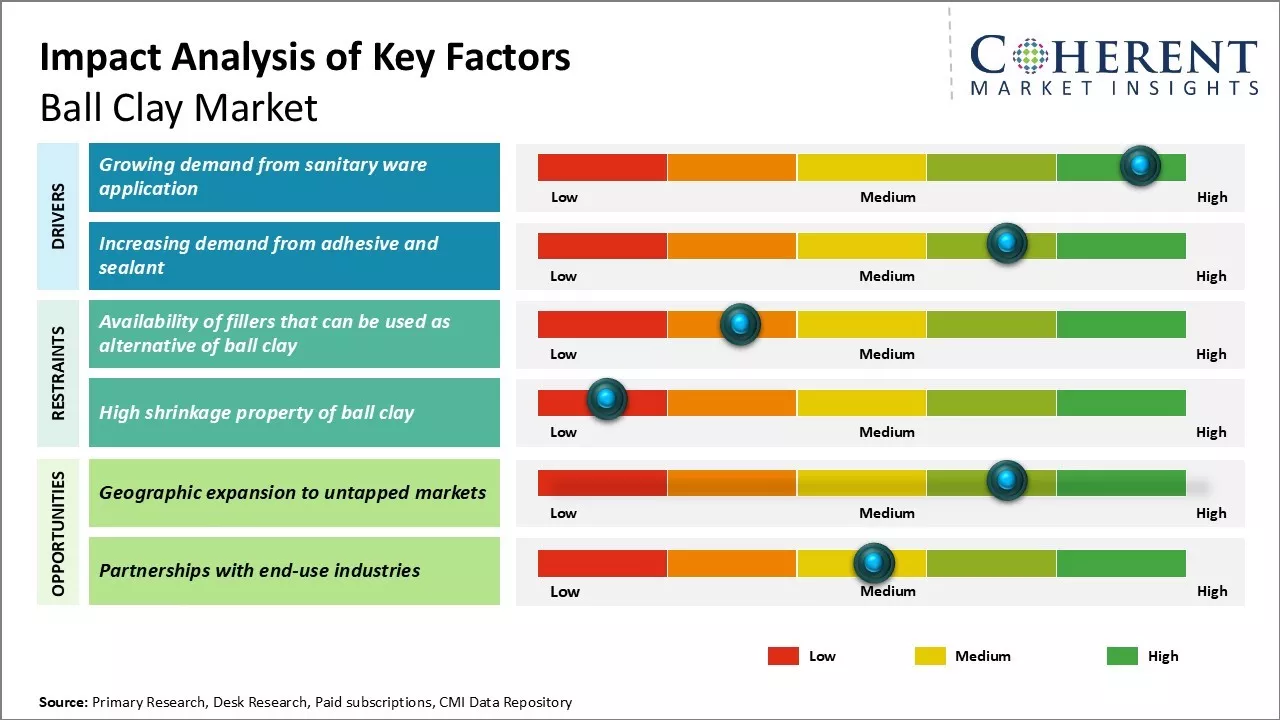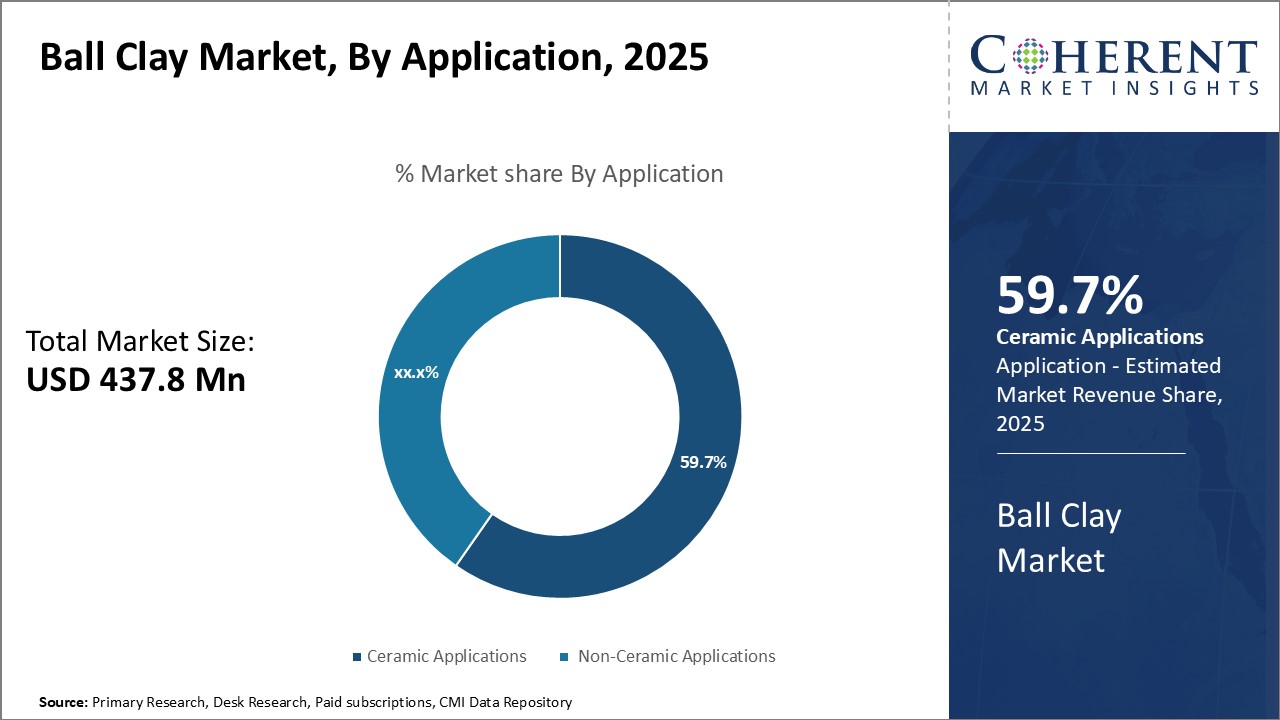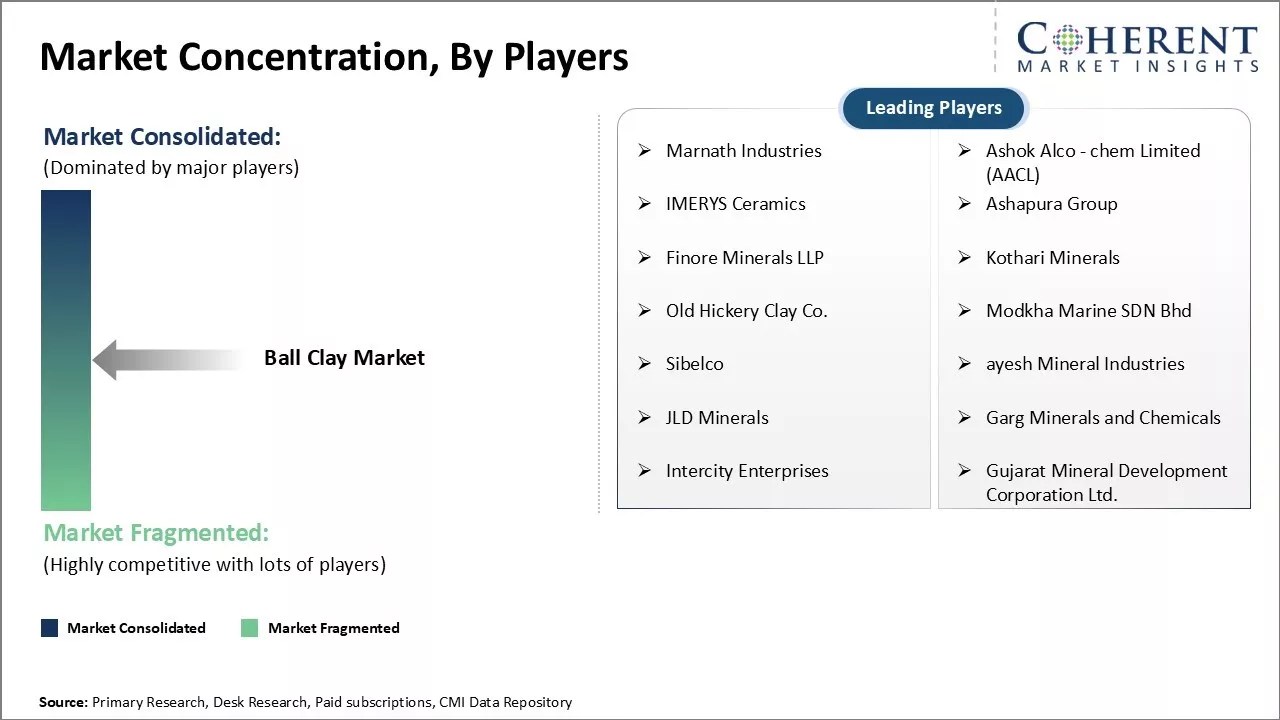Ball clay market is estimated to be valued at USD 437.8 Mn in 2025 and is expected to reach USD 592.2 Mn by 2032, exhibiting a compound annual growth rate (CAGR) of 4.4% from 2025 to 2032. The ball clay market has witnessed steady growth over the past few years driven by rising demand from key end-use industries such as ceramic, paints & coatings, and paper fillers.

Discover market dynamics shaping the industry: Download Free Sample
The ball clay market is expected to witness positive growth over the forecast period supported by increasing applications in various end-use industries. Rising demand for high-quality ceramic products from the construction industry has been a key factor boosting ball clay consumption. Additionally, growing paints & coatings industry in emerging nations is expected to generate numerous opportunities for ball clay producers over the coming years.

Discover high revenue pocket segments and roadmap to it: Download Free Sample
Insights By Application: Ceramic applications segment contributes the highest share of the market owing to its versatility and high demand
In terms of application, Ceramic applications segment is projected to account for 59.7% of the market share in 2025. This segment, which includes sanitary ware, wall and floor tiles, and tableware, has been leading the market. This dominance is driven by growing demand from the construction sector and a rise in global disposable income, leading to increased consumer spending on home decor and furnishings. Ceramics is the major end-use industry for ball clay as it requires ball clay for its high plasticity and refined particle size, which allows for better fiber reinforcement and defect healing during firing without shrinkage.
Insights By Form: Stone contributes the highest share of the market owing to its processing advantages
In terms of form, stone is expected to contribute 36.1% share of the market in 2025 owing to its unique advantage over other forms during processing at ceramic manufacturing facilities. In ceramic product manufacturing, ball clay in its stone form produces lesser dusty environment during handling and provides higher workability compared to powdered ball clay. It allows for uniform mixing without forming lumps or clods. Stone ball clay also contributes to energy savings as it requires relatively lesser crushing and pulverizing during processing.

Need a Different Region or Segment? Download Free Sample
Regional Analysis: Ball Clay Market
Dominating Region: Asia Pacific
Asia Pacific accounts for the greatest revenue share, holding 39.8% of the market share in 2025. In Asia Pacific, the dominance in this market can be attributed to factors such as strong industrial presence, supportive government policies, and strategic location of mines that provide access to global trade. Countries like China and India have robust manufacturing sectors that rely on ball clay for producing ceramics and cement.
Fastest-Growing Region: Europe
Meanwhile, the Europe region exhibits the fastest growth, led by the U.K. The European government has initiated infrastructure projects that seek to promote the development of domestic industries utilizing ball clay. Meanwhile, expanding construction sector has augmented demand for building materials like ceramic tiles that use ball clay as a key ingredient.
Ball Clay Market Outlook for Key Countries
China: Chinese companies like Longsheng Holding and Luoyang Qianyuan New Materials have greatly expanded supply through strategic acquisitions and investments in ball clay mines abroad including those in the U.S. and Europe.
India: Leading Indian ball clay producers including Kutch Mineral and National Minerals have increased focus on value-added products to cater to evolving requirements from end-use segments.
U.K.: U.K.-based ball clay suppliers such as El Alto and Solvista are benefitting from government incentives promoting industrialization and foreign investment projects.
Top Strategies Followed by Ball Clay Market Players
Emerging Startups in the Ball Clay Market
Several startups are bringing innovative technologies to the industry. Anthropic develops Artificial Intelligence (AI-based) solutions to automate quality inspection and additive manufacturing for ball clay product customization. Nonother applies nanotechnology to imbue self-heating and self-cooling properties for temperature-sensitive applications.
Sustainability is a key focus area. Claytech Materials produces brick additives from industrial waste clay to reduce landfill burden. EarthEpik utilizes bio-mimicry principles to bio-engineer highly absorbent clays with minimal processing. Claytech develops organic nanoclay masters for 3D printing of 100% biodegradable products.
Startups also address niche market needs. Calyx Sciences produces anti-microbial ball clay additives tailored for infection control in hospitals and laboratories. TerraSphere develops lightweight super-absorbent clay aerogels for high-performance moisture management in apparels and accessories. TerraSphere is a Dutch private company, established in 2008 by two former Microsoft employees. Its business is to analyze and extract information from earth observation satellites. the company provides actionable data and business intelligence on crops throughout the world. calyx takes clinical trials further and faster. its technology enables its customers to bring lifesaving treatments to market faster.
Key Takeaways from Analyst
Ball Clay Market Report Coverage
| Report Coverage | Details | ||
|---|---|---|---|
| Base Year: | 2024 | Market Size in 2025: | USD 437.8 Mn |
| Historical Data for: | 2020 To 2024 | Forecast Period: | 2025 To 2032 |
| Forecast Period 2025 to 2032 CAGR: | 4.4% | 2032 Value Projection: | USD 592.2 Mn |
| Geographies covered: |
|
||
| Segments covered: |
|
||
| Companies covered: |
Marnath Industries, Ashok Alco - chem Limited (AACL), IMERYS Ceramics, Ashapura Group, Finore Minerals LLP, Kothari Minerals, Old Hickery Clay Co., Modkha Marine SDN Bhd, Sibelco, ayesh Mineral Industries, JLD Minerals, Garg Minerals and Chemicals, Intercity Enterprises, and Gujarat Mineral Development Corporation Ltd. |
||
| Growth Drivers: |
|
||
| Restraints & Challenges: |
|
||
Uncover macros and micros vetted on 75+ parameters: Get instant access to report

To learn more about this report, Download Free Sample
Market Driver - Growing demand from sanitary ware application
Ball clay is increasingly being used for manufacturing high-quality sanitary ware products like toilet pans, wash basins, and other ceramic fixtures used in bathrooms. The special plasticity and fine texture of ball clay makes it highly suitable for making delicate and intricate shapes. Sanitary ware has emerged as a major end-use segment for ball clay over the years. With rapid urbanization and rise in disposable incomes in developing countries, the sales of sanitary ware products are increasing at a fast pace.
For instance, according to data published in April 2023 by the World Bank, 4.4 billion people, or 56 percent of the world's population, live in cities. By 2050, over seven out of 10 people will live in cities as a result of this trend, with the urban population predicted to have more than doubled from its current level. This is positively impacting the sales of premium sanitary ware products which have higher content of ball clay.
Market Challenge - Availability of fillers that can be used as alternatives of ball clay
One of the major challenges faced by the ball clay market is the availability of various filler materials that can easily replace ball clay in certain applications. Fillers like calcium carbonate, kaolin clay, and silica are widely used as substitutes for ball clay in various industries like paper manufacturing, paints & coatings, plastics, etc. These fillers offer advantages like lower price compared to ball clay and availability from local and regional sources. For instance, data released in October 2023 by the United States Geological Survey (USGS) indicates that kaolin, a widely used substitute for ball clay, saw its production in the U.S. rise from 4 million tons in 2010 to more than 5 million tons in 2020. This increase presents a considerable challenge to the current demand and pricing dynamics of ball clay.
Market Opportunity - Geographic expansion to untapped markets
One of the major opportunities for players in the ball clay market is to focus on expanding into new geographic regions which have remained untapped. Another promising avenue is Africa where the consumption of ball clay is presently quite low compared to potential. For instance, data published in July 2024, based on information from the United Nations Economic Commission for Africa (UNECA) in 2022, reveals that numerous African nations have set ambitious investment goals in infrastructure, real estate, and industrialization as part of their national development plans for the next 10 to 15 years.
Share
Share
About Author
Yash Doshi is a Senior Management Consultant. He has 12+ years of experience in conducting research and handling consulting projects across verticals in APAC, EMEA, and the Americas.
He brings strong acumen in helping chemical companies navigate complex challenges and identify growth opportunities. He has deep expertise across the chemicals value chain, including commodity, specialty and fine chemicals, plastics and polymers, and petrochemicals. Yash is a sought-after speaker at industry conferences and contributes to various publications on topics related commodity, specialty and fine chemicals, plastics and polymers, and petrochemicals.
Missing comfort of reading report in your local language? Find your preferred language :
Transform your Strategy with Exclusive Trending Reports :
Frequently Asked Questions
Joining thousands of companies around the world committed to making the Excellent Business Solutions.
View All Our Clients